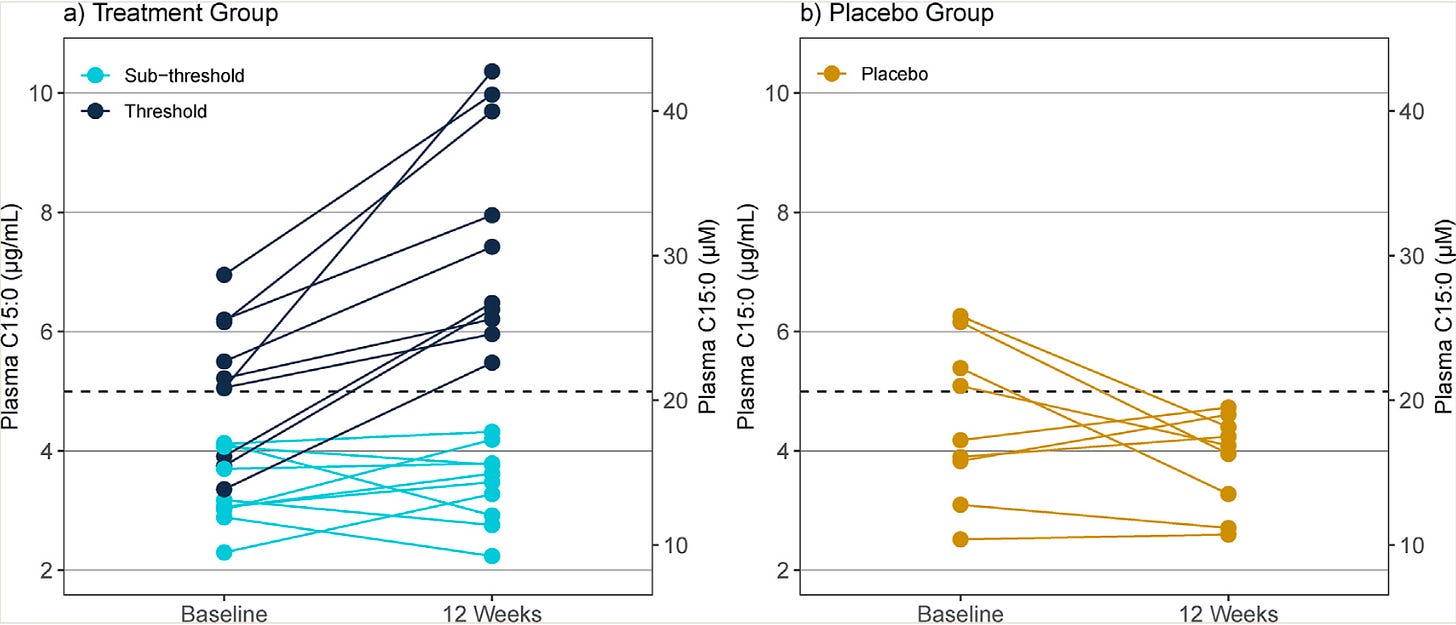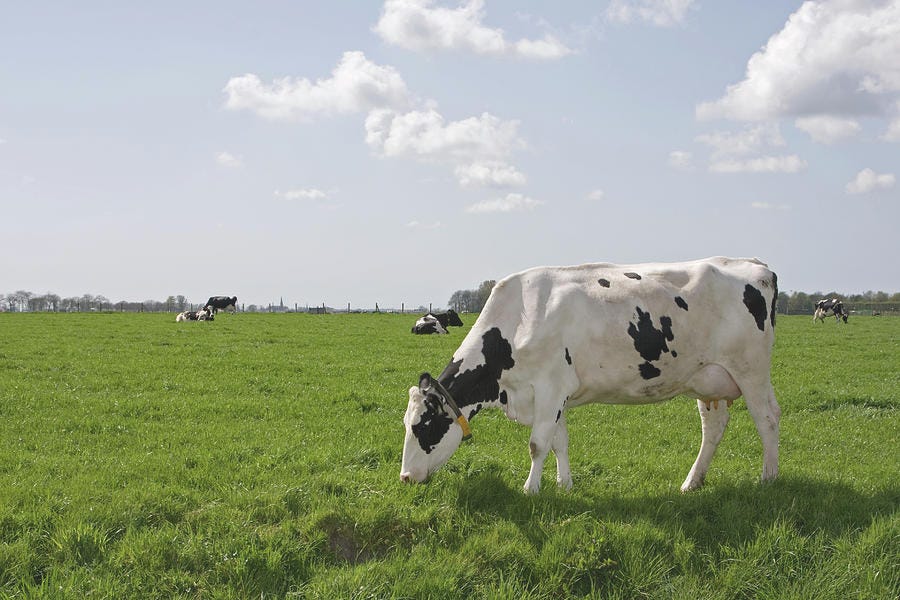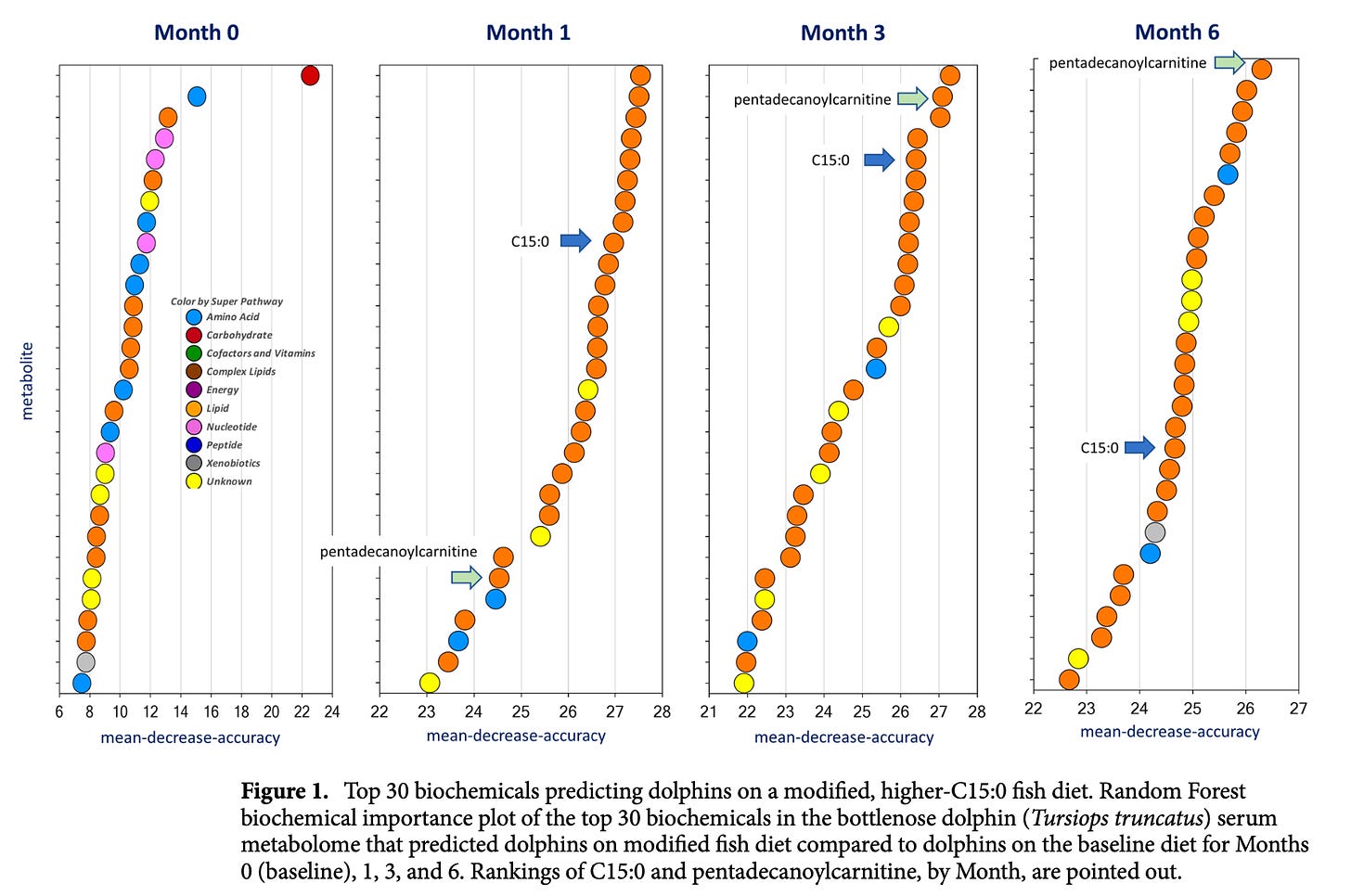15 Facts about C15 Fatty Acid
I’ve been getting a lot of questions about the newly discovered essential saturated fat, C15. We will touch on whether C15 is "essential," best dietary sources, and much more.
I’ve been getting a lot of questions about pentadecanoic acid, also known as C15:0 or “C15.”
You may have even seen ads of various influencers marketing the commercial product (Fatty15), which claims some rather impressive health benefits, like that it will calm you mood, improve your gut, liver and heart health, and help you age better.
So, I wanted to dig into the topic a bit. And, to be clear, I have no present affiliation with the company. I’m not going to offer you a discount code or affiliate link. This is just an independent evaluation of a commercialized molecule that appears to be of interest.
And, for fun, I thought I’d organize this letter into 15 Facts. So, here are 15 facts about C15.
(If you prefer to view rather than read, I’ve linked a video version at the end)
(1) What is C15?
Let’s define C15 and get the most boring fact out of the way. C15 is an odd chain saturated fat.
A saturated fatty acid is one without any double bonds and when we are naming fats the “C” represents the number of carbons, usually then followed by another number representing the number of double bonds.
So C18:1 is the mono-unsaturated fat oleic acid, as in olive oil.
C15, or properly, C15:0 is the topic of our discussion.
(2) C15 is an Essential Fatty Acid.
C15 is very likely an “essential” fatty acid and nutrient. This means that our bodies can’t make appreciable amounts of C15, and that lack of dietary C15 can contribute to poor health outcomes.
Indeed, there’s relatively strong evidence that:
C15:0 is not readily made by the body, or in appreciable amounts by the microbiome for that matter.
Lower C15 intake from diet and lower blood concentrations are each associated with poor health outcomes.
In pre-clinical and some clinical studies C15 has been shown to be a bioactive signaling lipid with physiologic effects that parallel the associative benefits of higher C15 levels as seen in larger scale population trials.
All this is to say, there’s a good case to be made that C15 is, in fact, an essential fatty acid.
(3) Population C15 Deficiency.
Building off the idea that C15 is an essential fatty acid, there should be evidence for C15 deficiency. There is, of course, as I alluded to. And the culprit for a population C15 deficiency is likely, in large part, misguided dietary recommendations.
Dietary guidelines tend to recommend reductions in saturated fat intake. And, lumped into that bucket, is whole fat dairy – a major dietary source of C15.
In fact, in the decades following on the recommendation to reduce saturated fat intake from dairy, whole fat milk intake plummeted 4-fold!
That was a BIG MISTAKE.
Multiple studies have demonstrated associations between higher dietary intake of full-fat dairy and reduced risk of type 2 diabetes and cardiovascular disease, or obesity in children.
This reality — that high fat dairy can be healthy — is becoming more and more mainstream.
Whether C15 is the mediating the presumed protective health effects of full fait dairy or, put another way, whether a C15 deficiency might be contributing to increased risks of chronic diseases remains to be proven.
But before we get into the nitty gritty, and speak about specific studies, I want to take a dive into how C15 came into the limelight.
(4) Thank you, Dolphins!
The discussion around C15 has really been promoted by Stephanie Venn-Watson, a Veterinary Epidemiologists who was turned onto the topic of C15 by studying Navy Dolphins.
Her research centered on how to help Dolphins, age better and healthier, and she and her colleagues discovered – to their surprise – that differences in C15 levels in the dolphins were a major differentiator of healthy aging in Dolphins.
Where dolphins were low in C15, they exhibited higher rates of metabolic syndrome, fatty liver and Alzheimer’s disease and overall worse aging and earlier death.
One thing led to another, and they found that there were many parallels with humans, where C15 deficiencies appeared linked to a host of similar age-related and chronic diseases.
(5) C15 and Insulin Resistance.
Interestingly, lower circulating C15:0 concentrations are associated with the development of insulin resistance and type 2 diabetes.
In one meta-analysis including 33 studies and ~100,000 adults, there was an inverse association between odd chain saturated fats, including C15:0, and type 2 diabetes.
And, in another meta-analysis of prospective trials, even after adjustment for BMI and waist circumference, higher levels of 15:0 were associated with ~20% reduced risk of developing type 2 diabetes.
(6) C15 and Fatty Liver in Children.
There appears to be an inverse association between dairy fat intake and C15 levels versus fatty liver in children. In other words, more dairy fat intake associated with less liver fat, and higher measured C15 levels likewise associates with less liver fat in kids.
To this I say to schools: “Kick the approved low fat sugary chocolate milk and bring back whole milk.”
(7) C15 and Longevity
The data on C15 and longevity are, in my opinion, a bit weaker but still interesting.
For example, in one study conducted in Sardinia, researchers assessed the plasma profiles of octogenarians in living in the high-longevity Easter Mountain area versus those living in the lower longevity Northern area, and found that C15 levels were trending higher in the high-longevity area.
I take these data, in isolation, with a grain of salt – given that the study was small and probably underpowered. But when you frame these data with those from dolphins and other animals on health span and lifespan, well… I’m left scratching my chin at the very least… and that’s a good thing when it comes to data on diet and longevity.
(8) C15 Levels in the Body Decrease with Age.
On this I say: tell granny to eat her pecorino and mullet… we will get to that in a moment.
(9) C15 Human RCT, Fatty Liver.
There have been very few human randomized trials on C15. That’s not “bad,” per se. It’s just the state of the literature. But I did want to give a nod to one in which young adults with obesity, mean BMI 33.4 kg/m2, were given C15 in a double-blinded controlled trial.
I won’t say the results were groundbreaking, but they were interesting. Specifically, in those adults who achieved a threshold level of C15 as a result of supplementation, >5 ug/mL, there did appear to be a significant improvement in liver damage markers.
That’s something. That said, I think one drawback of this intervention was the duration: 12 weeks, and if I were designing this trial in an ideal world, I would have wanted longer to see if positive effects emerged.
Nevertheless, credit where it’s due, these studies are getting done and I’m sure we will learn more as the data develop, including about what “optimal” circulating and membrane C15 levels should be. I’ve seen some ranges tossed around, like 0.16% and 0.64%, but I would love more data.
(10) C15 and Cellular Fragility.
The connection between C15 and metabolic diseases is interesting. But, of course, you should be asking – HOW does C15 promote metabolic health?
One model has to do with Cellular Stability, specifically membrane stability.
Cell membranes are made of fatty acids, and the composition of the membranes determines their properties, including their fragility and propensity to undergo a form of fat oxidation called peroxidation. I’ll try to keep this high level because it can get technical.
But briefly:
Deficiency levels of C15 in membranes (≤ 0.2% of total fatty acids), make cells like red blood cells susceptible to this form of oxidation.
Fragile and damaged blood cells can then be eaten up by immune cells, including resident macrophages in the liver.
The metabolic fallout involves more oxidation (peroxidation), programmed cell death (ferroptosis), and inflammation, which can be detected as increases in inflammatory markers and liver enzymes, on the path to liver disease.
Impaired liver function leads to insulin resistance and increased risk for metabolic syndrome, diabetes and cardiovascular disease.
For more, read this paper.
(11) Highest Dietary C15 Sources.
In terms of natural sources of C15, in the Western world it’s full-fat dairy.
In fact, C15 is a relatively good biomarker for dairy intake, with higher intake of fatty dairy associated with higher C15 levels, and higher full fat dairy intake and higher C15 levels being associated with better health outcomes.
But even among dairy, there’s a hierarchy: Pecorino cheese, a hard sheep’s cheese and one of my favorites, is particularly rich in C15. To get the recommended 200mg of C15:0 per day, you just need half an ounce (!), or 14 grams of pecorino per day… that’s nothing!
And to be honest I eat it by the 100-gram serving.
Seafood can also be a source of C15, with mullet, catfish and seabass being higher in C15.
(12) Changes in Cow Feed Change C15 in Dairy.
That said, variations in the way cows are fed can alter C15 in their milk. Specifically, there is a direct positive association between % of grass fed (versus corn fed) to cows and C15:0 content in their milk, with cows fed 0%, 30%, and 100% fresh grass containing 0.77%, 0.99%, and 1.3% C15:0, respectively.
This translates to nearly a 2-fold difference in dietary C15:0 intake, depending on whether cows are fed grass or corn.
(13) C15 and Endocannabinoids.
This one came out of left field for me. To put it concisely, a direct C15 metabolite, pentadecanoylcarnitine, which is C15 with a carnitine molecule attached to it, is a full agonist of endocannabinoid receptors, CB1 and CB2.
It’s actually this metabolite of C15 that really pops out among dolphins on high C15 diets. And, in human cell studies, pentadecanoylcarnitine also appears to lower inflammatory markers like IL‐1α and MCP‐1.
The human clinical effects remain to be determined, but there is potential for therapeutic effects in inflammation, pain, mood, and sleep.
(14) C15 Does Not Replace Omega-3.
There has been talk about C15 versus Omega-3. I’ll cut to the cheese, I mean chase… I really don’t think C15 is better than omega-3, nor can it replace omega-3.
For more on that, see this excellent video by my friend Nick V.
(15) Dolphin Cheese.
You can milk a dolphin. There are its mammary slits. If anyone knows a marine biologist wanting to make a buck, I have a business proposal… just kidding. I’m not that shellfish. And, yes that pun was on porpoise.
For a Video Version:










Thanks for another great post Nic
As a regular full-fat raw cow's milk drinker, this is moo-sic to my ears 🐄